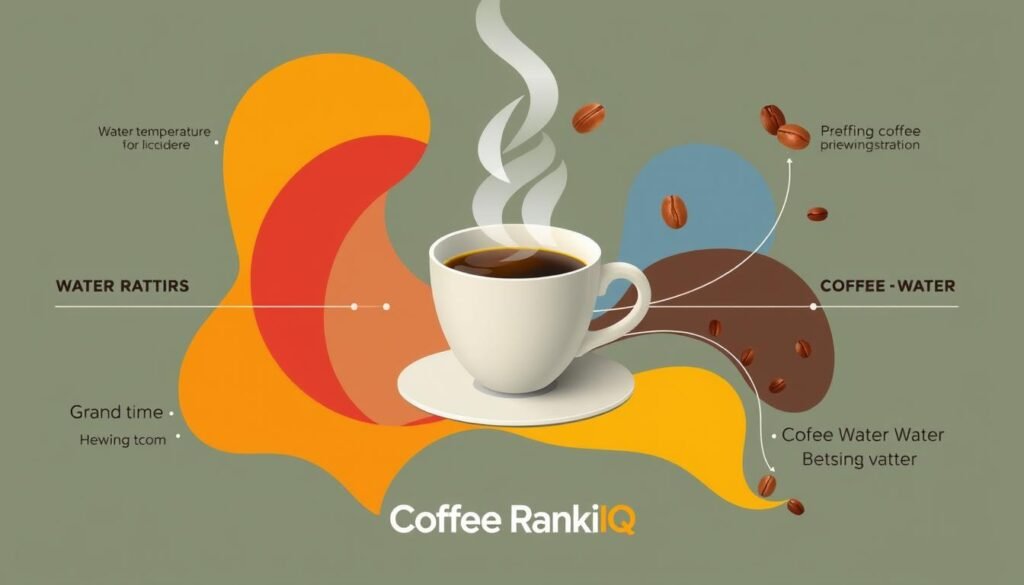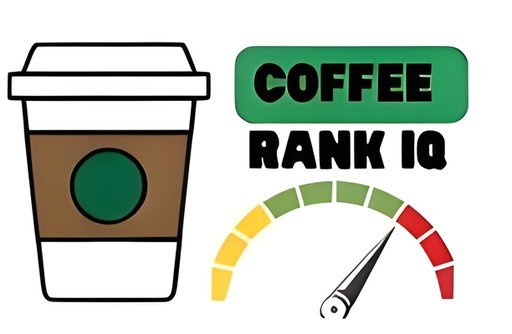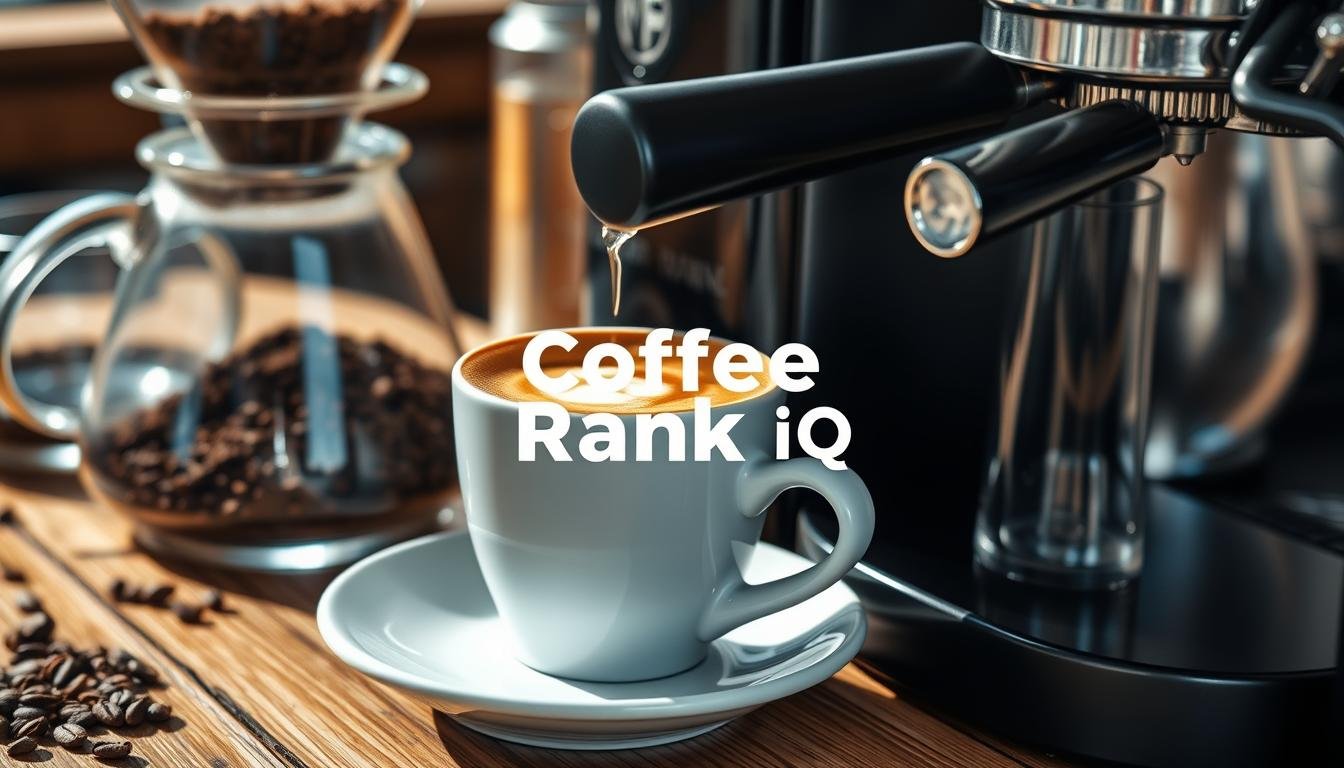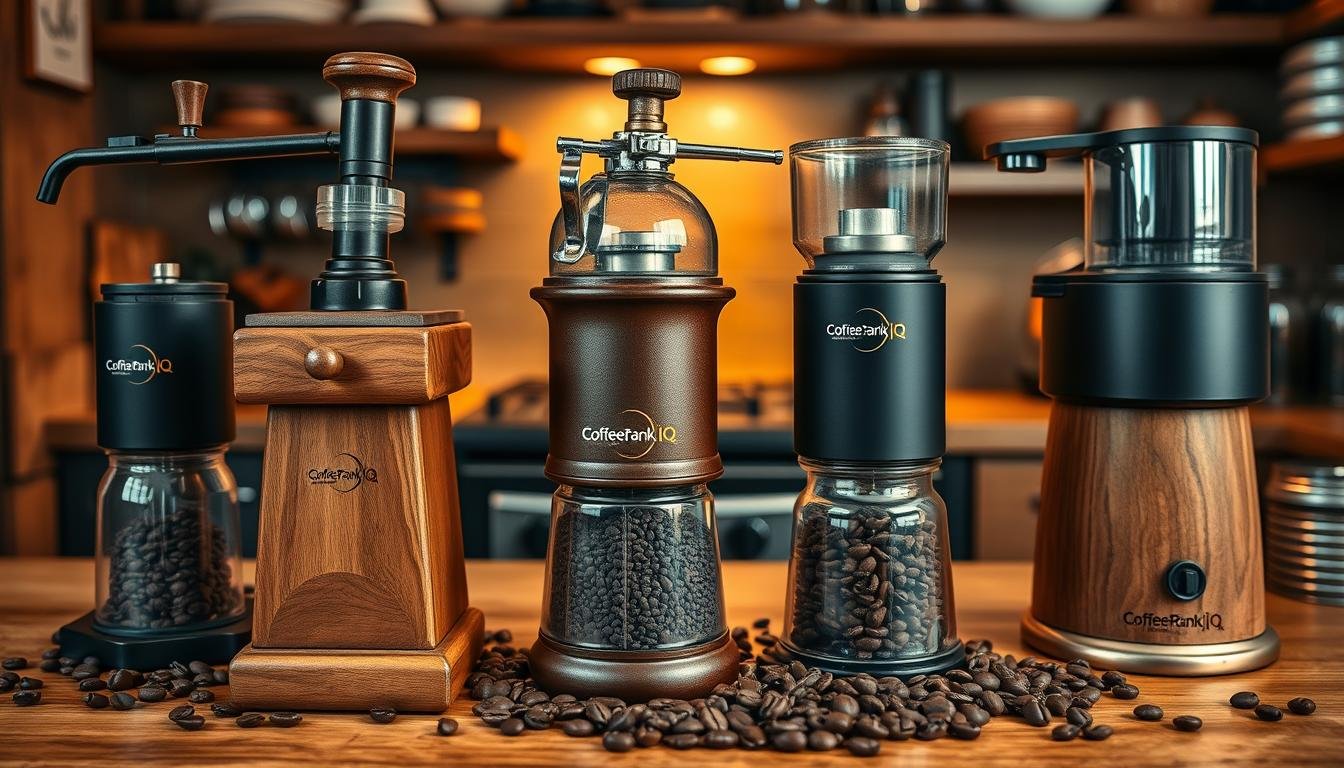Did you know that brewed coffee is composed of a staggering 98% water and only 1-1.5% dissolved solids from the coffee grounds? The concentration or strength of your beloved cup of joe is determined by the Total Dissolved Solids (TDS) – the higher the TDS, the bolder the brew. This intricate balance of water and coffee solids is the foundation of the science behind coffee extraction and the key to unlocking the perfect flavor profile in your favorite brewing methods.
This article will delve into the coffee chemistry, extraction parameters, and various brewing techniques that transform those tiny coffee grounds into the rich, aromatic beverage we all know and love. From the impact of grind size and contact time to the role of water quality and temperature, you’ll gain a comprehensive understanding of the factors that influence the extraction efficiency and flavor characteristics of your coffee.
Key Takeaways
- Brewed coffee is 98% water and 1-1.5% dissolved solids from coffee grounds.
- The concentration or strength of coffee is determined by Total Dissolved Solids (TDS).
- Grind size and contact time impact the rate of extraction during brewing.
- Brewing variables like water temperature, turbulence, and filtration affect flavor perception.
- Achieving ideal extraction balances desirable flavors for a well-rounded, creamy cup of coffee.
Understanding Coffee Extraction
To brew a delightful cup of coffee, it’s essential to understand the coffee extraction process. This process involves the interaction between water, the universal solvent, and the ground coffee beans. During the roasting stage, the complex sugars in the coffee beans are transformed into simpler ones, and the acids are broken down, creating a balanced flavor profile.
Water: The Universal Solvent
Water plays a crucial role in the coffee extraction process. As the universal solvent, it dissolves the various flavor compounds present in the ground coffee. The extraction occurs in a specific order, with the acids and fats being extracted first, followed by the sugars, and finally, the plant fibers.
Roasting Coffee
The roasting process is a vital step in shaping the coffee’s flavor profile. During roasting, the chemical structure of the coffee beans is altered, reducing complex sugars into simpler ones and breaking down acids. This transformation creates a balanced and nuanced flavor that is essential for achieving the perfect cup of coffee.
Brewing: Understanding Extraction
The brewing process is where the magic happens. As the hot water interacts with the ground coffee, the extraction of the flavor compounds begins. Understanding this extraction process is key to crafting the ideal cup. The strength and quality of the coffee are influenced by factors such as the ratio of coffee to water, the grind size, and the brewing time.
| Brewing Method | Grind Size | Brew Time | Strength |
|---|---|---|---|
| Pour Over | Fine to Medium-Coarse | 2-4 minutes | Medium to Light |
| French Press | Coarse | 4-5 minutes | Full-Bodied |
| Espresso | Very Fine | 20-30 seconds | Intense and Concentrated |
| AeroPress | Fine to Medium | 1-2 minutes | Balanced and Clean |
| Auto-Drip Brewer | Medium-Fine | 5-8 minutes | Consistent and Balanced |
By understanding the coffee extraction process, water’s role as a solvent, the impact of roasting, and the nuances of brewing, you can unlock the full potential of your coffee and consistently enjoy the perfect cup.
Factors Influencing Extraction

When brewing the perfect cup of coffee, several key factors influence the efficiency and quality of the extraction process. Understanding these variables is crucial for achieving the desired flavor profile and balance.
Contact Time and Grind Size
The amount of time the coffee grounds and water are in contact, known as contact time, plays a pivotal role in extraction. Longer contact time allows for more thorough extraction, but can also lead to over-extraction, resulting in a bitter, astringent taste. The grind size of the coffee also significantly impacts extraction – smaller, finer grounds have more surface area exposed to the water, leading to faster and more complete extraction.
Water Quality
The quality of the water used for brewing can greatly affect the extraction process. High-quality, filtered water with low mineral content, or “soft” water, is ideal for coffee brewing. Hard water, with high mineral levels, can pose challenges in extracting the desired soluble compounds, potentially leading to an imbalanced or unpleasant flavor profile.
Water Temperature
The optimal water temperature for coffee brewing falls between 195 and 205 degrees Fahrenheit. This range allows for efficient extraction of the coffee’s flavor compounds without burning or scalding the grounds. Temperatures outside of this optimal range can result in under-extraction (too cool) or over-extraction (too hot), affecting the final taste of the coffee.
“Adjusting brewing variables such as coffee dose, grind size, water temperature, and extraction time can influence TDS concentration in the final brew.”
By understanding and carefully controlling these key factors – contact time, grind size, water quality, and water temperature – coffee enthusiasts and professionals can optimize the extraction process and consistently produce rich, balanced, and flavorful coffee.
The Science Behind Coffee Extraction and Brewing Methods

The science of coffee extraction involves intricate chemical processes that transform the complex compounds within coffee beans into the flavorful liquid we enjoy. This extraction process is influenced by several key variables, each of which plays a crucial role in determining the final taste profile of your brew.
Extraction Variables
At the core of coffee extraction are three primary chemical reactions: hydrolysis, dissolution, and diffusion. Hydrolysis breaks down larger molecules into smaller, soluble compounds, while dissolution occurs as the water dissolves various compounds from the coffee grounds. Diffusion then allows these solubles to move from areas of high concentration (the grounds) to areas of lower concentration (the water).
The efficiency and balance of these processes are directly influenced by factors such as contact time, grind size, water quality, and water temperature. Mastering the art of coffee brewing requires an in-depth understanding of how these variables interact and impact the final cup.
- Contact time: The duration of interaction between the water and coffee grounds plays a crucial role in extraction. Longer contact times allow for more complete extraction, but can also lead to over-extraction and bitterness.
- Grind size: The surface area of the coffee grounds directly affects the rate of extraction. Finer grinds expose more surface area, resulting in faster and more complete extraction, but can also lead to over-extraction and sediment in the cup.
- Water quality: The mineral content and pH of the water used for brewing can significantly impact the taste and mouthfeel of the coffee. Optimal water chemistry helps to balance the extraction of desirable compounds.
- Water temperature: The temperature of the water affects the rate of extraction and the solubility of different coffee compounds. Brewing at the ideal temperature range (195-205°F) ensures efficient extraction while avoiding the extraction of undesirable flavors.
By understanding the science behind these extraction variables, coffee enthusiasts can fine-tune their brewing methods to consistently achieve the perfect balance of flavors and aromas in their cup of coffee.
“Mastering the art of coffee brewing requires an in-depth understanding of how these variables interact and impact the final cup.”
Achieving Ideal Extraction
The key to brewing a delectable cup of coffee lies in achieving the ideal extraction. This balance between under-extracted and over-extracted coffee is crucial for unlocking the full potential of your beans and crafting a harmonious flavor profile.
Undextracted vs Overextracted Coffee
An under-extracted coffee will often taste sour, sharp, or thin, with an oily body and a quick finish. This occurs when the water fails to fully extract the desirable compounds from the coffee grounds, leaving behind the more acidic and less soluble elements. In contrast, an over-extracted coffee will be dry, astringent, and bitter, as the water has drawn out too many of the undesirable compounds, such as tannins and polyphenols.
The ideal extraction strikes a delicate balance, where all the desirable flavors – the acids, fats, oils, and sweetness – are extracted without crossing into the realm of bitterness and astringency. This harmonious extraction is the hallmark of a well-brewed cup of coffee, one that showcases the inherent complexity and nuance of the beans.
| Characteristic | Under-Extracted Coffee | Over-Extracted Coffee |
|---|---|---|
| Flavor | Sour, sharp, thin | Dry, astringent, bitter |
| Body | Oily | Thin |
| Finish | Quick | Long, unpleasant |
Achieving the ideal extraction is a delicate dance, requiring the barista to carefully adjust factors such as grind size, water temperature, and brew time. By mastering this balance, you can unlock the true potential of your coffee, revealing a rich, well-rounded, and deeply satisfying cup that showcases the perfect harmony of sweetness, acidity, and bitterness.
Popular Brewing Methods Explained
The world of coffee brewing is vast and diverse, with a range of methods to explore. From the elegant pour over to the robust French press, each brewing technique offers unique flavors and experiences. Let’s dive into the details of some of the most popular coffee brewing methods.
Pour Over
The pour over method is renowned for its ability to highlight the nuanced flavors of a coffee. Using a fine grind size and a slow, controlled extraction, pour over brewing allows you to carefully manipulate the water flow and temperature to extract the most desirable notes from the beans. This method is ideal for brewing one to two cups at a time, enabling you to experiment with different coffee varieties and find your perfect flavor profile.
French Press
The French press, a full-immersion brewing method, produces a bold, full-bodied cup of coffee. By steeping the grounds in hot water and then pressing the plunger to separate the liquid from the solids, the French press extracts a rich, concentrated flavor. This method is well-suited for those who enjoy a robust, smooth coffee experience.
Espresso
Espresso is a unique brewing method that uses pressure to force hot water through a fine, densely-packed coffee grind. The result is a concentrated, intense shot of coffee that forms the base for many popular coffee drinks, such as lattes and cappuccinos. Espresso brewing requires precision and consistency to ensure the desired flavor profile and mouthfeel.
AeroPress
The AeroPress is a portable, easy-to-use brewer that yields a clean, full-flavored cup of coffee. By using a fine-to-medium grind and a gentle pressing action, the AeroPress extracts a smooth, balanced brew in about a minute. This method is a favorite among travelers and coffee enthusiasts who value convenience without sacrificing quality.
Auto-Drip Brewer
The auto-drip brewer is a common choice for home brewing, offering convenience and the ability to make larger batches of coffee. These machines typically use a medium-fine grind size and automatically brew a full pot of coffee, making them a practical solution for those who value ease of use and the ability to serve multiple cups at once.
Each of these brewing methods has its own unique characteristics and requirements, catering to a range of coffee preferences and brew styles. By understanding the nuances of each method, you can explore the world of coffee and find the perfect brewing technique to suit your taste buds.
| Brewing Method | Grind Size | Brew Time | Flavor Profile |
|---|---|---|---|
| Pour Over | Fine | 3 minutes | Balanced, nuanced |
| French Press | Coarse | 4 minutes | Full-bodied, robust |
| Espresso | Very fine | 25-30 seconds | Concentrated, intense |
| AeroPress | Fine-to-medium | 1 minute | Clean, full-flavored |
| Auto-Drip Brewer | Medium-fine | 5-10 minutes | Balanced, convenient |
The choice of brewing method ultimately comes down to your personal preferences and the type of coffee experience you’re seeking. Whether you’re a pour over enthusiast, a French press devotee, or an espresso connoisseur, there’s a brewing method out there that will perfectly suit your coffee-loving palate.
Conclusion
By understanding the science behind coffee extraction and the various brewing methods available, coffee enthusiasts can unlock the full potential of their favorite beans and consistently brew the perfect cup of coffee at home. Whether you prefer the clarity of a pour over, the full body of a French press, or the intensity of an espresso, knowing how to manipulate the key variables of extraction can help you achieve the desired flavor profile.
With this knowledge, coffee lovers can experiment and find the brewing method that best suits their personal taste preferences. By mastering the art of coffee extraction, you can elevate your home brewing experience and savor the rich, complex flavors that make each cup of coffee a true delight.
Remember, the journey to the perfect cup of coffee is all about striking the right balance between variables like water temperature, contact time, and grind size. Embrace the science, explore different brewing techniques, and let your personal preferences guide you on your quest for the ultimate coffee experience.
FAQ
What is the role of water in coffee extraction?
Water acts as a universal solvent, dissolving the various flavor compounds in the coffee during the brewing process.
How does the coffee roasting process impact extraction?
Roasting transforms the coffee bean, reducing complex sugars into simpler ones and breaking down acids, creating a balance of flavors that can be effectively extracted.
What is the order in which compounds are extracted during the brewing process?
During brewing, water first extracts the acids and fats, then the sugars, and finally the plant fibers from the ground coffee.
What factors influence the efficiency and quality of the coffee extraction process?
Key factors include contact time, grind size, water quality, and water temperature.
What are the chemical reactions involved in the science of coffee extraction?
The main processes involved are hydrolysis, dissolution, and diffusion, which break down, dissolve, and distribute the various compounds from the coffee grounds into the water.
What is the goal of coffee brewing in terms of extraction?
The goal is to achieve an ideal extraction, where all the desirable flavors (acids, fats, oils, sweetness) are extracted from the coffee grounds without going too far and extracting undesirable bitterness and astringency.
What are some popular brewing methods and their unique characteristics?
Some popular methods include pour over, French press, espresso, AeroPress, and auto-drip brewers, each with their own grind size, contact time, and extraction profiles.



